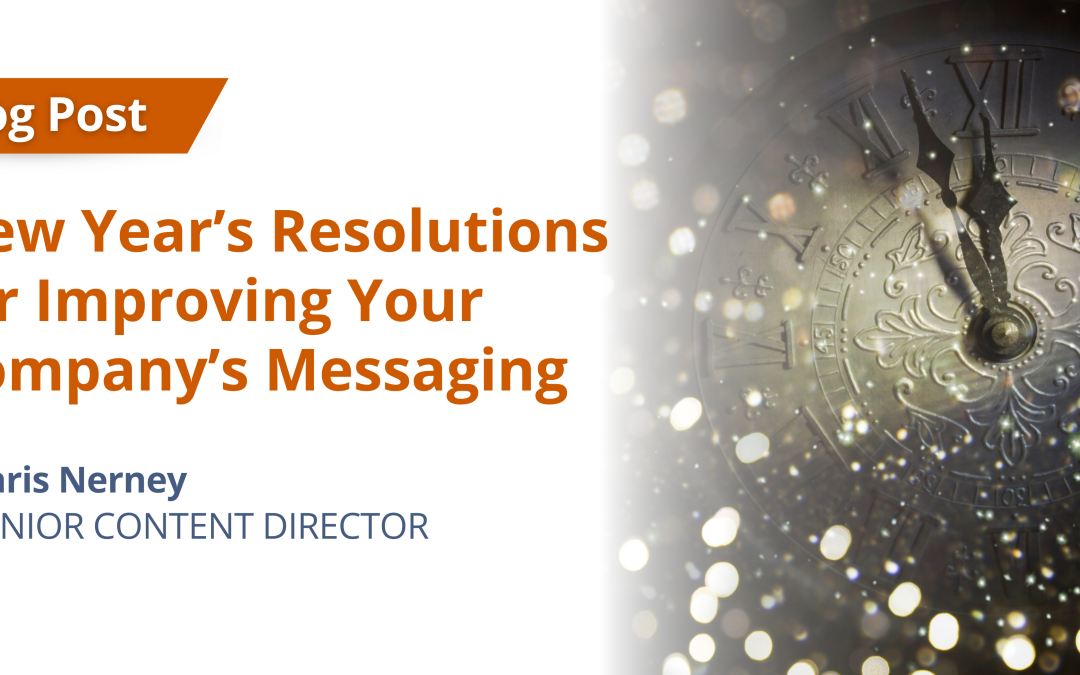
by Chris Nerney | May 28, 2025 | Blog
Some health technology entrepreneurs are absolutely convinced their company has a unique, revolutionary solution that will transform healthcare. And they will not hesitate to tell you!
Most, however, are more grounded. They only have to look around to see that the problems their solution is designed to solve – whether it’s clinical data quality, patient identity, billing accuracy, etc. – have attracted the interest of other clever and well-intentioned people. They have competition! Worse, some of these sector rivals are well-funded.
Which doesn’t mean your solution is any less genuinely transformative to healthcare consumers, providers, payers, or researchers. What it does mean is you likely face a formidable challenge in rising above the noise in your sector to attract and capture the attention of potential customers and investors. After all, there are a lot of stories being told out there.
So how can healthcare PR and marketing pros make their company’s story compelling enough to break through and stand out in a crowded market? For starters, health tech companies can gain a market advantage by clearly articulating (and repeating) across multiple channels what problems their solutions solve and how these solutions benefit patients. Why should customers choose your solution and not a competitor’s? You need a great answer to that question.
Hone your marketing language to highlight your company’s competitive differentiators. Once you’ve locked in on a framework for your messaging, you can deploy several specific techniques to help your health tech company rise above the clamoring masses. These include:
Practice precision marketing
The marketing messages that resonate with potential customers such as provider organizations or payers may not resonate with investors. While a hospital or health plan will want to know what your technology costs and how it would help them improve care quality or operational efficiency, they’re not interested in a graphic showing the projected growth of your startup’s market sector. Investors, on the other hand, care deeply about a sector’s growth potential as well as a prospective portfolio company’s strengths and weaknesses (particularly its technology and leadership team) relative to the competition.
It is essential that you learn the needs and pain points of each target audience and then tailor a message that specifically addresses them. Try to get feedback from members of your target audience (or people who understand their concerns and priorities) and then modify as necessary.
Go multimedia
We may be in the technology business, but humanity sells. The human connection is a powerful thing; people like to hear and see other people talk. That’s one of the reasons why podcasts have become so popular. If there is someone in your company who could shine on a podcast, do not hesitate to get that person some training and some bookings.
No matter how nervous your subject matter expert may be, once they see the positive response internally and externally, they’ll be pestering you for more podcast opportunities. Then they’ll ask for help getting an agent.
You also can use multimedia in social media and in press releases. Spice up your messaging with pictures, graphics, and even short videos. You won’t need to hire a crew for a three-camera shoot, either; videos can easily be recorded on a smartphone.
Get customers to tell their story
I know, it’s one of the hardest things in marketing. A health tech company’s customers – whether they’re a hospital, health system, payer, or academic center – may not want to get involved in your marketing efforts because 1) they’re pretty busy doing their own jobs, and 2) they worry about being perceived as shills for a vendor. From their perspective, those aren’t unreasonable concerns.
But you won’t know what your customers say until you ask. Suggest doing a white paper on their experiences with your solution or ask for one of their spokespeople to join you on stage at an industry conference or for a podcast. People like to talk about their successes and impart advice to colleagues. It’s all upside to them.
One great selling point for healthcare marketing and PR pros who are trying to get a customer to share their experiences is to emphasize that the customer’s story (and yours) centers around how they were able to better serve patients using your technology, not the merits of the technology itself (which should be apparent in the telling of the story). Again, it’s an opportunity for the customer to talk about what they’re doing to help patients, research, or efforts to control healthcare costs.
Conclusion
To succeed in highly competitive markets, health tech vendors need a coherent message centered around how their solution benefits both patients and potential customers. By tailoring these messages to targeted audiences, leveraging the power of multimedia to build human connections, and working with customers to communicate powerful success stories, health tech vendors truly can stand out in a crowded market.

by Chris Nerney | Jan 8, 2025 | Blog
The start of any year is an ideal time for healthcare companies to review and, if necessary, revise their brand messaging. The industry moves fast, and the message that resonated in January may be gathering mold a few quarters later. Or a healthcare company may want to reach a new target audience as its product evolves and market dynamics change.
Here are three possible marketing and public relations resolutions for 2025 that, if embraced, will help healthcare companies raise their profiles and distinguish themselves from the growing crowd.
Lose the meaningless jargon
Stop telling people your company is “transforming healthcare.” It’s a meaningless phrase used by virtually every healthcare startup. I know because I’ve typed variations of the word “transformational” at the behest of countless clients. I haven’t crunched the numbers, but I’d say there are almost as many companies claiming they’re transforming healthcare as there are “visionaries,” “innovators,” and “trailblazers” on LinkedIn.
Likewise, try to eliminate words and phrases such as “value proposition” and “leveraging,” which are best left for business-school debates. As Amendola founder Jodi Amendola wrote in Forbes last summer, such words “are so tired that they have come to mean virtually anything to anyone, and in turn, they have lost all effectiveness in conveying a unique, memorable marketing and communications message.”
If you’re not unique, you don’t stand out. And if you don’t stand out, you’re essentially invisible. Not exactly the “value proposition” you want from your marketing and PR initiatives, is it? Don’t give potential customers a reason to tune you out.
I also think we’re at the point where healthcare companies need to evolve their messaging beyond terms such as “patient journey” and “social determinants of health,” both of which feel dry and disconnected from real people. Unfortunately, I have no better suggestions. Perhaps an innovative, trailblazing visionary can step forward.
Establish a multimedia presence
When social media took off, some healthcare companies became aggressive early adopters while others held back, not sure whether LinkedIn, Twitter, Instagram, and other social platforms were worth their time. If they had to do it all over again, I suspect the laggards would have moved faster to expand their messaging through these channels.
Don’t make the same mistake with multimedia. Audio and video are powerful mediums not only for communicating information, but for connecting with people. For as powerful as the printed word can be, nothing compares to listening to a person talking or watching them speak.
Printed words can’t communicate vocal inflections, eye contact, or a sincere smile the way multimedia can. While these things may not have anything to do with your product’s capabilities or a customer’s specific problems, they can convey a level of trustworthiness and credibility that the printed word can’t match.
A lot of healthcare companies are taking advantage of audio and video podcasts to deliver their message. It would be smart to use those acquired skills to produce short videos for LinkedIn and other social media platforms that make sense for your company. Including videos in press releases is another way to attract media coverage. None of this requires the construction of a video studio; a smartphone and uncluttered background is enough.
Get customers to tell your story
One of the most common challenges facing healthcare companies is persuading customers to help spread the word about their products and services.
Easier said than done, I know. There often are valid reasons why a customer doesn’t want to be co-opted into your PR strategy: They’re busy, they don’t want to be perceived as endorsing a product, and besides, it’s not their job to promote your “transformational” solution.
Nobody, however, is going to tell your story as effectively as a satisfied, real-world customer whose problems you helped to solve. This type of testimonial will resonate with a prospective customer far more deeply than your company pitch deck. Further, having a customer willing to speak publicly will exponentially increase your company’s chances of getting onto conference stages (and thus in front of your target audience). That alone will separate your company from the pack.
Your best chance of getting a customer to talk about your product is to emphasize the genuine benefits to them and remove obstacles (such as investments of time) that are disincentives to participation. If they are truly impressed with your product and you make the process easy for them, customers will be far more likely to talk about how your company’s product helped them. If companies with similar challenges are listening, this messaging will catch their attention.

by Chris Nerney | Jul 24, 2024 | Blog
My colleague Philip Anast recently shared some advice from the Wall Street Journal via the Advisory Board regarding situations “where it’s better to slow down at work.”
Let’s be honest: In the hyper-paced world of healthcare public relations and marketing, where there’s a product rollout, speaker submission, or awards deadline around every corner, the notion of “slowing down at work” is downright antithetical. When you’re managing multiple accounts – and trying to make each feel as if they are your highest priority – you instinctively fear that slowing things down will derail your strategic timelines, frustrate your clients, and send your blood pressure soaring. Why make an already intense job even more stressful?
The answer is there are times in PR and marketing where slowing down is essential to doing the best job for your clients, your agency, and your sanity. Here are three situations when slowing down pays off in PR and marketing. These apply to in-house marketing/PR pros, who face pressures similar to those of agency workers.
When you’re the final set of eyes
Marketing and PR pros must create and process high-level, detailed content every day. Thought-leadership bylines, case studies, white papers, press releases, sales sheets, analyst pitches – it never ends. If your client is a life sciences company, you may be writing about concepts that may be ever-so-slightly outside your wheelhouse. That’s OK – you probably didn’t go to medical school, and your yearslong devotion to Grey’s Anatomy will only get you so far.
Still, when you’re delivering content assets, it’s important to get everything right. And no matter how many people look at the “final” draft of a byline, press release, or other public-facing deliverable, someone will be the last set of eyes before the news release is sent to Cision or the byline to your client’s CEO.
Even if it’s the 10th time you’ve read it, do so with intense focus just one more time. Read slowly, scan for typos, and pay attention to flow and impact. This is your last chance! Put another way, if there’s something wrong that you didn’t catch, you may be catching flak from the client, who is paying the agency good money to not mess up content.
When your client wants to do something impulsive and perhaps ill-advised
Clients can be quite emotional. Which is understandable. They’re under pressure on multiple fronts from competitors and investors. They are responsible for executing on product, market, and growth strategies. They’re probably working 70 hours a week. Plus their chief marketing officer just abandoned the company for a new job. And their kids have the flu.
Nonetheless, when the client’s CEO decides what the company needs to do is issue a press release every day for a week before HLTH to carpet-bomb the market into recognizing the pioneering brilliance of their platform (something I heard an investor for a startup insist on), you must slow their roll. Politely but firmly explain how a press release a day doesn’t really align with the rhythm of how the healthcare tech media operates – “Company X made a big splash today. I can’t wait to see what they’ve cooked up for tomorrow!” said no tech reporter, ever – and that it also would be a waste of money. (The money message eventually got through to the investor.)
Similarly, if a CEO wants to confront that editor from Healthcare IT News who omitted the company from a roundup of startups to watch in Sector Z in the coming year and clearly harbors a grudge against us, you must counsel restraint. Emphasize the importance of cultivating long-term relationships with the media, analysts, and others in the industry ecosystem who could help the company down the road. Just giving your excitable clients some time to vent often is enough to defuse a mini-crisis.
When there’s a full-blown PR crisis
Sometimes an actual crisis will arise – your client’s product is the subject of a recall or warning, a customer files a major lawsuit, an investigative article in the mainstream media that mentions the company in a negative light blows up on social media, etc. You’ve got to move fast or things will quickly spin out of control!
Making a public statement that can be easily contradicted, however, will only worsen the problem. Thus, it is imperative that you know the facts. Make sure you take the time to gather all the facts surrounding the issue and are interpreting them correctly. You only have one chance to respond the first time to a crisis. Make it count.
Conclusion
In the PR and marketing biz, you need to think fast and move fast. Sometimes, though, slower is better.

by Chris Nerney | Feb 28, 2024 | Blog
Healthcare marketing and public relations agencies work closely with clients on crafting effective messages designed to gain the attention of (and prompt action from) their potential customers, investors, media outlets, awards organizations, conference organizers, and other target audiences.
Clients and agencies routinely rely on email and collaborative platforms such as Slack and Teams to communicate about messaging ideas and strategies. Still, there’s no substitute for live, verbal conversations. And while meeting in person is always best, the pandemic made Zoom calls a simple and convenient way of life in the professional world. Other than not knowing how tall everyone is on Zoom, it’s just like being in a room together!
When it comes to creating strategic, high-value content assets for clients – such as “thought leadership” bylines, case studies, and white papers – it is essential that agencies and clients arrange what we refer to as an “intake call” to discuss the asset’s target audience, goals of the content, main message, and major takeaways.
Intake calls are both a resource and an opportunity; thus, failure to take full advantage of these sessions can undermine the client’s goals and the ability of the agency to create compelling content. Unfortunately, far too many intake calls are unproductive and fail to provide the agency’s account directors and writers with enough direction to ensure quality content assets. Inevitably, the writing suffers, leading to more time wasted on editing and rewriting that could have been avoided.
Among the many reasons why intake calls go off the rails:
There’s no predetermined topic. I’ve been on my share of calls where the topic of the content asset had not yet been specified. As a result, much time is consumed just kicking around ideas. Once an idea is chosen, the call participants then have to hammer out a message and supporting themes. Without preparation, this process can be highly inefficient, which means the agency team may not get all the information they need from the call within the allotted time.
The “subject matter expert” (SME) is unprepared. Client SMEs are very knowledgeable about their areas of expertise. They’re also quite busy, particularly if the SME is a CEO. Thus, even if a topic has been preselected or an outline produced as a guide for the call discussion, the SME may not have had time to do any prep work. This also can lead to an inefficient and unsuccessful intake call.
The SME lives in the weeds. Some client SMEs can clearly and fluently communicate their company’s technology, market strategy, and product use cases. Other SMEs are CTOs. Just kidding! Seriously, though, SMEs who immerse themselves in technological details can struggle to concisely explain to a non-tech audience how their companies’ platform or tools can help customers.
Too many people on the call. Though this doesn’t happen much with start-ups, I’ve written custom content for large technology vendors as a freelancer and have been on calls with eight, 10, or more client-side participants. I’m not naming names, but one company rhymes with Oracle. These “cast of thousands” mega-calls can be incredibly frustrating and unproductive.
Intake call best practices
So what can marketing/PR agency pros do to ensure they and their clients get the most value they can out of intake calls?
Prepare a list of questions to guide the discussion. Giving the conversation a framework and some direction can make an intake call more efficient and productive. What’s the technology or healthcare challenge? What’s at stake for patients, clinicians, payers, etc.? What are the possible solutions?
Get down to business. I like to chat, and I like learning about people I’m working with. (Is that so wrong?) But when you only have 30 minutes to capture a client’s thoughts about a complex healthcare challenge, it’s best to smoothly move past initial pleasantries and get the show on the road.
Make the client verbalize the value of the asset. Even if you know the topic of the content asset, even if you have a tentative title, and even if you have bunch of on-point questions, it’s always a good idea to ask the client to explain 1) the target audience 2) what the goal of the asset is, and 3) how they would describe the asset to a colleague (“This byline is about…”). The more clarity an agency’s writer and account director have, the more likely they will produce an asset that meets or exceeds the client’s expectations.
Conclusion
Both healthcare technology startups and their marketing/PR agencies are far too busy to waste time on unproductive content asset intake calls. While it’s hard to control how ready clients are for intake calls, agency account and content directors can optimize the value of these Zoom meetings by being prepared, guiding client participants through the conversation, and seeking clear language about the topic and goals of a content asset.

by Chris Nerney | Nov 15, 2023 | Blog
Healthcare PR and marketing agency pros work with multiple clients at a time. That’s a lot of technologies, services, business strategies, marketing messages, workflows, timelines, and personalities to understand and manage.
It’s easy for us to feel overwhelmed because healthcare technology clients by definition are working on cutting-edge technologies that can be challenging to comprehend, never mind explain to an audience. Conversing regularly with healthcare startup founders about the clinical-grade, model-informed, reverse-engineered algorithm they developed to transform healthcare as we know it – when they weren’t working their side gig as a highly regarded neurosurgeon – is a humbling experience. My encyclopedic knowledge of BoJack Horseman episodes barely measures up.
But here’s where things get even more complicated: Not only does each client have all that stuff I mentioned in the first paragraph, they also are trying to reach multiple audiences.
That matters, because to craft an effective message you need to both identify and understand the target audience. The first question I ask clients when we’re on a call with a subject matter expert to get information for a writing assignment – a byline, a press release, a white paper – is, “Who’s the target audience?” Even if I already know, I’ll ask anyway just to make sure we’re all on the same page and to get more details. Plus it’s a great icebreaker!
Know what each audience cares about
At the most basic level, every healthcare technology company has three distinct audiences: customers (both potential and existing), investors, and the media. Let’s start with the less complicated audiences: investors and the media.
Investors view healthcare technology as, well, an investment. So while they may thoroughly believe in the technology and what it will do for patients, providers, payers or some other stakeholder, their primary interest is whether their investment pays off. Investors want to hear about the market opportunity, growth strategy, financial and growth metrics, the expertise and experience of the management team, and how the company intends to become profitable.
A media audience is looking for an interesting story. That might be the background of your client’s founders, the scope of the challenge your client is trying to address, and how many lives the client’s product or service will change. Even media outlets that drill down into the details of healthcare technology, business, and policy want to cast the content they publish in human terms.
You can best understand what type of content specific media outlets are interested in publishing by actually reading what they publish. (Pro tip!) If your client is all about the revenue cycle, you’re not likely to draw interest from a website that covers medical devices.
Customers are more complicated because many healthcare companies may be trying to reach several subsets of customers. For example, one of Amendola’s clients I write for markets its platform to hospitals, health information exchanges, labs and clinics, and health plans. Each of those target audiences has its own priorities and needs. As a marketing/PR agency, it is our job to effectively address the specific pain points of each target audience.
Listen, research, and listen some more
So how can we best understand each of the client’s target audiences? One way is to talk with someone at the client who interacts regularly with customers and prospective customers.
For example, if the target audience is customers and potential customers, I would want to hear from sales executives. They are the people who listen to customers describe their business goals and challenges, explain what problems they need to overcome, and articulate what they need (or don’t need) from the type of solution the client is selling. Once you can identify the problems a customer wants solved, you have the raw ingredients for crafting a targeted, compelling message using the customer’s language.
Unfortunately, sometimes it’s hard for a PR/marketing agency team to get time with a client’s sales exec because they’re busy selling (hopefully!). It’s much more common for agencies to work with the client’s technologists, who typically are among the founders. While their ability to explain the company’s technology within the context of various use cases is indispensable, it’s the sales team that understands challenges from the customer’s perspective. They have an outside-in perspective, rather than the inside-out view of many technologists.
A less direct way to learn about a target audience is through online research. That includes using ChatGPT and other generative AI tools to find information. (Just make sure it’s not hallucinated info.) Learning the lay of the land within a client’s competitive sphere provides more perspective to help inform the content you create. Large consulting agencies such as McKinsey and Accenture have ambitious healthcare practices that offer comprehensive market analyses.
Developing customer personas also can help marketing/PR agencies hone their messages by providing a crystal-clear picture of a target audience. What are the backgrounds, values, preferences, and pain points of the chief technology officers targeted by your client? They undoubtedly would be different to those of the chief financial officer or chief medical officer. Interviews, surveys, and feedback can be used to refine those personas.
Conclusion
No healthcare client has a single target audience. All of them at some point will need to communicate the appropriate messages to investors, the media, and various customer groups. Marketing/PR professionals must be fluent in all these languages to ensure they are helping clients achieve their goals.




